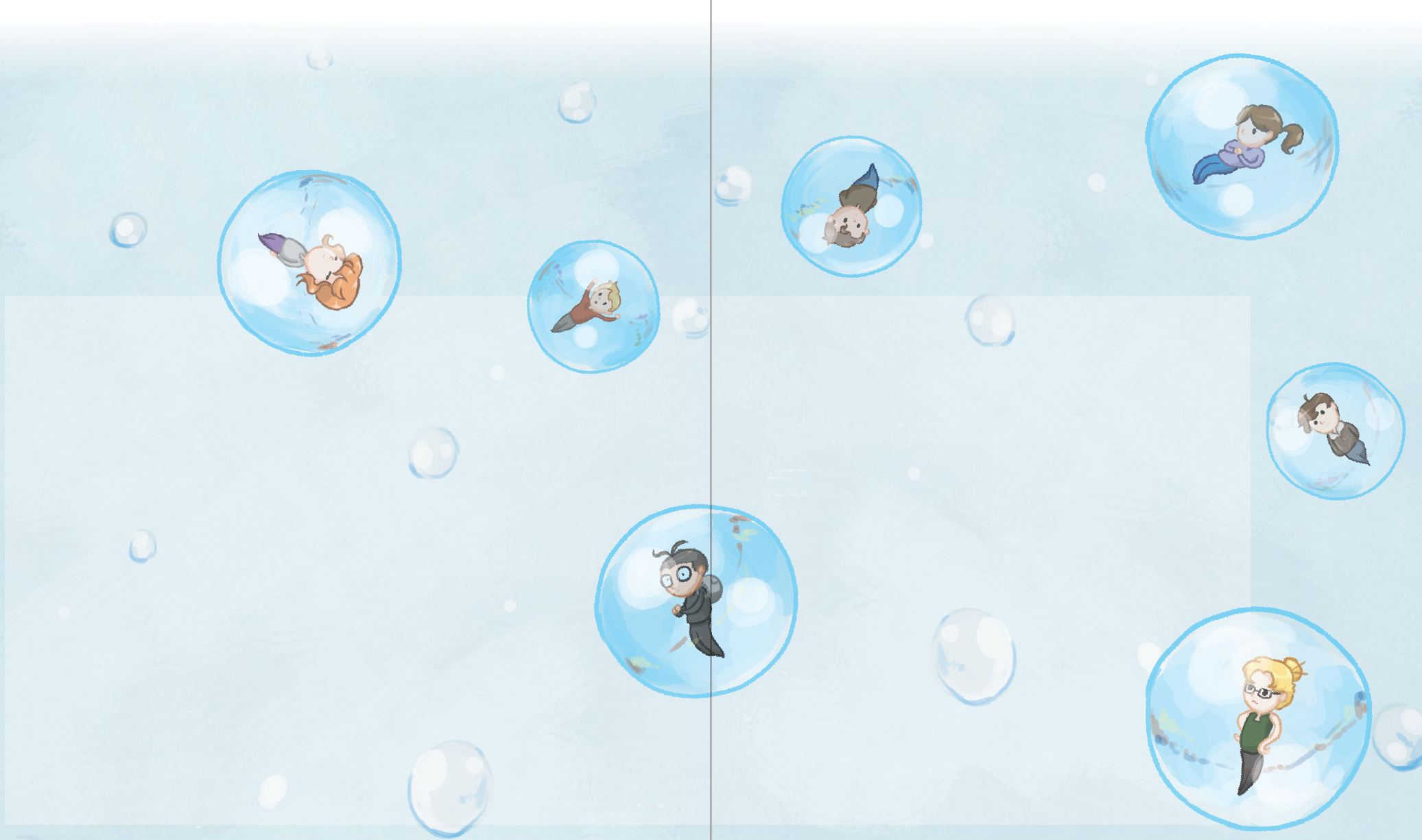By Vanessa Broadbent (The Cascade) and Anthony Biondi (Illustrations) – Email
Print Edition: January 14, 2015
When we think of university life, we often picture insane frat parties or endless amounts of student-run clubs or associations waiting for us to join. University is typically portrayed as a place where a large group of students have endless fun and take advantage of everything the university offers, especially a thriving social life.
We grow up with this image of university, expecting it to be the same for us. Then we come to UFV.
UFV isn’t exactly known as the most exciting university around. In fact, most students attend their classes and leave, leaving many communal areas on campus empty and deserted.
Student Union Society (SUS) president Ryan Petersen thinks it could be because of the average age of the general student, and UFV’s large continuing studies program.
“Our average age of the student is more mature,” he says. “[Students] are trying to have a career, or a job, or a family, or other responsibilities outside of the university while trying to work through their program.”
Petersen isn’t the only one who has noticed the lack of student engagement on campus. UFV garden club president Samuel Harder explains that a large portion of students commute to school, making it difficult to attend campus events.
“It’s a commuter school, so spending that extra half an hour on a Friday evening to go and water your lettuce is kind of tough,” he says. “For us, it kind of seems like a chore to go out to an association event because it doesn’t line up with your classes. So unless I’m at campus and it’s right after that, I probably won’t go.”
Most UFV students haven’t attended other universities, but we’ve all heard the stories of campuses overflowing with students and a plethora of events to attend every day. “I think, when you look at UFV, we always try and compare it to other institutions, and I think that does UFV a bit of disservice,” says Petersen.
However, SUS clubs and associations officer Alisha Atkinson thinks other universities do not necessarily have a more engaged student body. “It’s not that they have more engaged students [by] percentage — I think they just have more students,” she says. “It looks like there’s more engagement because there are so many more students.”
Large universities have more students, which will raise the number of students engaged on campus, but the percentages of clubs and associations per student do not line up. UBC has over 350 clubs and associations active on campus and a student enrolment of 50,000 students, and SFU has over 185 clubs and associations and an enrolment of over 35,000. UFV has 62 registered clubs and associations and an enrollment of around 15,000 students, the lowest ratio of student groups to students when compared to the offerings of the two larger BC institutions.
UFV Urbanists treasurer Dylan Anderson, a fourth-year geography and urban planning student, says large universities are more likely to have engaged students due to the high number of students living in residency.
“By nature, you don’t get the same student life and engagement such as SFU or UBC [have]. People are living there and they’re sort of stranded at their campus. Therefore, they have to keep themselves occupied with what’s available for them,” he explains.
The lack of student engagement at UFV has had an effect on clubs and associations on campus — especially when it comes to recruiting new members. Vessal Jaberi, president of the biology and chemistry student association (BCSA), has a hard time talking to students on campus about getting involved.
“It’s so difficult to engage people, because everyone just has headphones in and is either in the Timmy’s line or going to class,” he says. “It’s awkward to go up to someone and say ‘Hey, you don’t know me — come to our event.’”
Even SUS has noticed that most clubs and associations struggle to find new members. “There’s a lot of handfuls of people that want to be involved, but the struggle is finding the bulk members of these groups who want to come to these events and care about these various issues,” Atkinson says. Even if a club or association does have a core group of members, there’s always the threat of members graduating or losing interest. “It’s hard to keep those members year after year after year. Also, we’re a university; people’s interests change, people graduate, people transfer. It’s a constantly moving thing,” she says.
Advertising on campus is one of the main ways student groups can let students know they exist and are hosting events, but even that can be difficult.
“It doesn’t make it exactly easy to engage students either because of the way that we have to advertise our events. They’re either too expensive or they’re not efficient,” says Jaberi. “When you put a poster on the public notice boards, no matter what colour you choose … it’s going to blend with the other 50 posters. People don’t see it.”
Posters may not be the best form of advertising for clubs and associations, but they are one of the only options. Aaron Levy, CIVL station manager, doesn’t think hanging posters up around campus is very effective.
“There are a lot of posters around in general. Students are walking around, they don’t generally think about getting involved on campus … I think it’s more effective to talk to people one on one,” he says. “I think students just don’t have time in general, specifically on a campus like this where engagement isn’t something that’s always happening.”
Clubs’ and associations’ other main way of communicating with students is social media. Nearly every university student has a Facebook account and checks it on a regular basis, making Facebook the perfect platform for campus groups to interact with students. Levy thinks Facebook can be more successful when trying to engage with the modern student.
“Facebook is actually kind of relevant because they can just click and find out more information about it, where [if] you’re looking at a poster, you’re usually directed to an email, a phone number, something where you have to go do more research,” he says.
While Facebook may be a powerful resource for student groups, only 36 — fewer than half — of UFV’s clubs and associations have active Facebook pages. Furthermore, while SUS’s website does have a list of all clubs and associations on campus, no email addresses, links to websites, or any way of directly contacting the groups without an intermediary is given. This makes it even more important for campus groups to make sure they create a strong online presence.
Harder also says getting recognized by SUS as a UFV club or association — which can lead to assistance in event funding and other services, can take a lot of work, requiring official meetings to make quorum while navigating promotions regulations.
“The hard part is [making quorum] … if you read the student associations handbook, one the things that you come across is that you can’t advertise on SUS bulletin boards, which are most of the bulletin board around school [before your group is registered], so you’re kind of in this catch-22 of ‘I need to get members out to become a club so that I can advertise, but I need to advertise so that I can get members,’” Harder says. “They were like, ‘Yeah, host some events, get people out,’ but I can’t host events with funding from student fees, it has to be out of my pocket until we’re official.”
Regardless of clubs’ and associations’ efforts, most students at UFV, according to student group leaders, are missing out on academic opportunities. Anderson says in the first few years of his degree, he wasn’t involved on campus, but enjoyed it once he was.
“I really think once I started [getting involved], everything just improved. My grades improved, I liked coming to school more, I wasn’t as eager to go home, and it makes the experience overall better,” he said. “We’re not UBC, you’re not going to get the same experience. So it’s up to you to put in the effort to get that.”
Harder adds that groups can expand the real work of doing things related to an academic interest beyond the limited time allotted to directed discussions and lectures.
“To sit down with other people and talk about ideas and plans and things you want to see happen is a pretty great thing that doesn’t happen in a classroom. You go to a science lecture and you’ll learn about the cell for an hour and 20 minutes, but you don’t get that [exchange] of ideas. You can find it if you’re involved in a club.”
Despite the numerous benefits that come with getting involved on campus, it’s just not something that interests most students. Maybe it’s the thought of having to add one more commitment into our already hectic lives. Maybe it’s a fear of stepping out and being “that new person.”
Petersen has noticed this trend on campus as well. “The people who are trying to find out more are always a little bit daunted and intimidated, but the people who are already there always want new people and are looking for new members. You [have] to get over your embarrassment and being shy,” said Petersen.
Anderson thinks students just need to step out and try something new for once. “Put in the effort, jump in with both feet, and try it out,” he says. “If, by the end of it, you don’t like it, that’s fine. You don’t have to stick around, but give it a shot and put yourself out there. You won’t know until you try it.”
In the print issue, the wrong version of this article was used. It has been updated online to include comment from Aaron Levy and additional comment from Samuel Harder.



